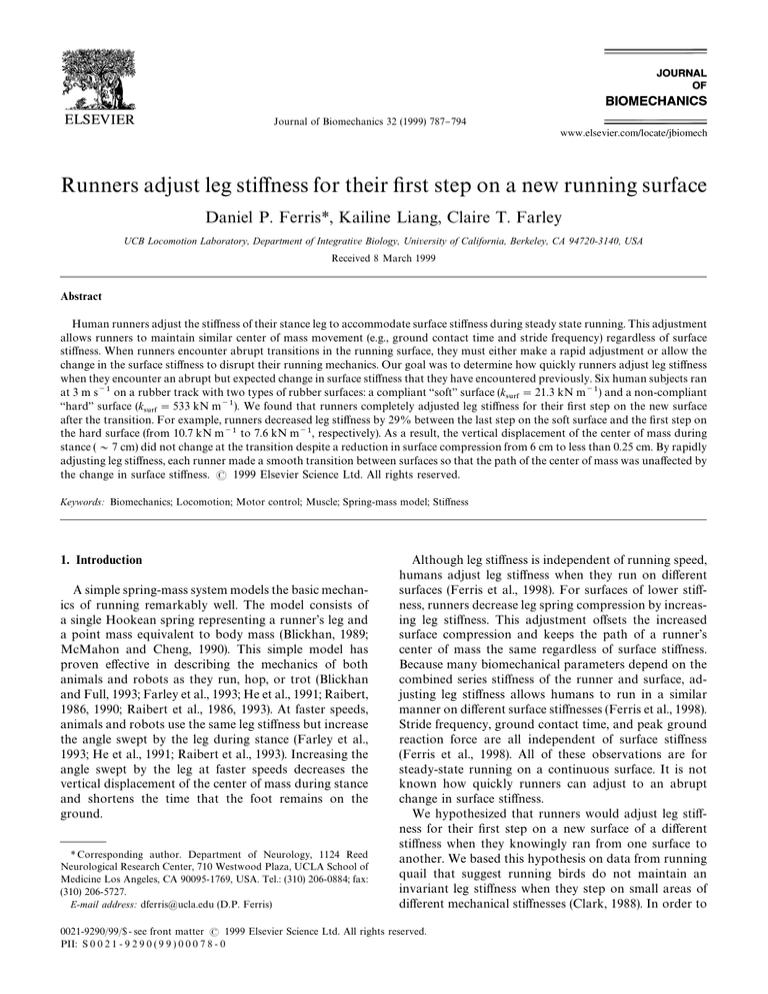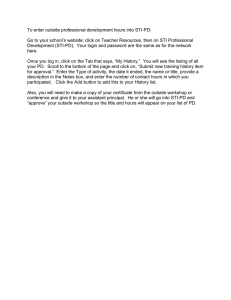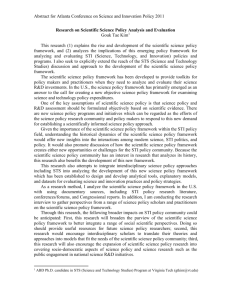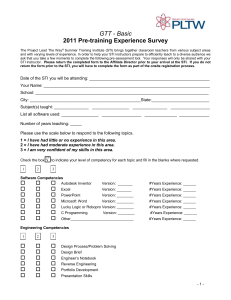
Journal of Biomechanics 32 (1999) 787}794
Runners adjust leg sti!ness for their "rst step on a new running surface
Daniel P. Ferris*, Kailine Liang, Claire T. Farley
UCB Locomotion Laboratory, Department of Integrative Biology, University of California, Berkeley, CA 94720-3140, USA
Received 8 March 1999
Abstract
Human runners adjust the sti!ness of their stance leg to accommodate surface sti!ness during steady state running. This adjustment
allows runners to maintain similar center of mass movement (e.g., ground contact time and stride frequency) regardless of surface
sti!ness. When runners encounter abrupt transitions in the running surface, they must either make a rapid adjustment or allow the
change in the surface sti!ness to disrupt their running mechanics. Our goal was to determine how quickly runners adjust leg sti!ness
when they encounter an abrupt but expected change in surface sti!ness that they have encountered previously. Six human subjects ran
at 3 m s\ on a rubber track with two types of rubber surfaces: a compliant `softa surface (k "21.3 kN m\) and a non-compliant
`harda surface (k "533 kN m\). We found that runners completely adjusted leg sti!ness for their "rst step on the new surface
after the transition. For example, runners decreased leg sti!ness by 29% between the last step on the soft surface and the "rst step on
the hard surface (from 10.7 kN m\ to 7.6 kN m\, respectively). As a result, the vertical displacement of the center of mass during
stance (&7 cm) did not change at the transition despite a reduction in surface compression from 6 cm to less than 0.25 cm. By rapidly
adjusting leg sti!ness, each runner made a smooth transition between surfaces so that the path of the center of mass was una!ected by
the change in surface sti!ness. 1999 Elsevier Science Ltd. All rights reserved.
Keywords: Biomechanics; Locomotion; Motor control; Muscle; Spring-mass model; Sti!ness
1. Introduction
A simple spring-mass system models the basic mechanics of running remarkably well. The model consists of
a single Hookean spring representing a runner's leg and
a point mass equivalent to body mass (Blickhan, 1989;
McMahon and Cheng, 1990). This simple model has
proven e!ective in describing the mechanics of both
animals and robots as they run, hop, or trot (Blickhan
and Full, 1993; Farley et al., 1993; He et al., 1991; Raibert,
1986, 1990; Raibert et al., 1986, 1993). At faster speeds,
animals and robots use the same leg sti!ness but increase
the angle swept by the leg during stance (Farley et al.,
1993; He et al., 1991; Raibert et al., 1993). Increasing the
angle swept by the leg at faster speeds decreases the
vertical displacement of the center of mass during stance
and shortens the time that the foot remains on the
ground.
* Corresponding author. Department of Neurology, 1124 Reed
Neurological Research Center, 710 Westwood Plaza, UCLA School of
Medicine Los Angeles, CA 90095-1769, USA. Tel.: (310) 206-0884; fax:
(310) 206-5727.
E-mail address: dferris@ucla.edu (D.P. Ferris)
Although leg sti!ness is independent of running speed,
humans adjust leg sti!ness when they run on di!erent
surfaces (Ferris et al., 1998). For surfaces of lower sti!ness, runners decrease leg spring compression by increasing leg sti!ness. This adjustment o!sets the increased
surface compression and keeps the path of a runner's
center of mass the same regardless of surface sti!ness.
Because many biomechanical parameters depend on the
combined series sti!ness of the runner and surface, adjusting leg sti!ness allows humans to run in a similar
manner on di!erent surface sti!nesses (Ferris et al., 1998).
Stride frequency, ground contact time, and peak ground
reaction force are all independent of surface sti!ness
(Ferris et al., 1998). All of these observations are for
steady-state running on a continuous surface. It is not
known how quickly runners can adjust to an abrupt
change in surface sti!ness.
We hypothesized that runners would adjust leg sti!ness for their "rst step on a new surface of a di!erent
sti!ness when they knowingly ran from one surface to
another. We based this hypothesis on data from running
quail that suggest running birds do not maintain an
invariant leg sti!ness when they step on small areas of
di!erent mechanical sti!nesses (Clark, 1988). In order to
0021-9290/99/$ - see front matter 1999 Elsevier Science Ltd. All rights reserved.
PII: S 0 0 2 1 - 9 2 9 0 ( 9 9 ) 0 0 0 7 8 - 0
788
D.P. Ferris et al. / Journal of Biomechanics 32 (1999) 787}794
compare our experimental "ndings with the results that
would be expected if runners did not adjust leg sti!ness
for the new surface sti!ness, we constructed a computer
simulation of a spring-mass model on a compliant surface. We used the computer simulation to assess how the
global running mechanics (e.g., path of the center of mass,
contact time, running speed) would be a!ected by the
transition in surface sti!ness without a concomitant leg
sti!ness adjustment.
2. Methods
Six healthy female subjects (body mass 52.7$3.1 kg,
leg length 88$3.5 cm; mean $ s.d.) between 21 and 25
years of age participated in this study. The university
committee for the protection of human subjects approved the experimental protocol and subjects provided
informed consent. We recorded ground reaction force
(1000 Hz) and high-speed video (200 Hz) as subjects ran
at 3 m s\ on a 17 meter rubber track with two force
platforms (AMTI, Inc.) mounted beneath the middle of
the track. We cut sections of rubber to match the surface
area of the force platforms so that the rubber surface did
not transmit force o! the force platform (Fig. 1). We
determined the runner's speed with two infrared sensors
placed on both sides of the force platforms (3 m apart)
and accepted trials if the running speed was within
$5% of 3 m s\. We also integrated the horizontal
ground reaction force with respect to time to measure the
change in forward speed for each step.
We used two types of rubber to create four di!erent
surface conditions for the subjects. The compliant `softa
rubber surface had a sti!ness of 21.3 kN m\ and the
non-compliant `harda rubber surface had a sti!ness of
533 kN m\. In the "rst two conditions, we covered the
entire length of the track with either the soft rubber
surface or the hard rubber surface. For the third condition, we covered the "rst-half of the track with the soft
surface and the second-half with the hard surface (Fig. 1).
For the fourth condition, we covered the "rst-half of the
track with the hard surface and the second-half with the
soft surface. We randomized the order of the surface
conditions so that each subject ran on the four conditions
in a di!erent order. We collected ground reaction force
data for the following steps: last step on the soft surface
before transition to the hard surface (SH0), "rst step on
the hard surface after transition from the soft surface
(SH1), one step from a continuous hard track (H), last
step on the hard surface before transition to the soft
surface (HS0), "rst step on the soft surface after transition
from the hard surface (HS1), and one step from a continuous soft track (S). Subjects performed as many practice
trials on each surface condition as they wanted (typically
5}10 trials). We then collected data for four trials on each
surface condition for each subject.
Fig. 1. Side view of the experimental set-up. Subjects ran down a track
with two force platforms mounted beneath the rubber surface. For the
transition trials, we covered half of the track with a compliant `softa
rubber surface (striped, k "21.3 kN m\) and half with an extremely
sti! `harda rubber surface (black, k "533 kN m\).
During stance, a runner's e!ective vertical sti!ness
(k ) governs the vertical motion of the center of mass
(McMahon and Cheng, 1990). This e!ective vertical sti!ness does not correspond to any physical spring in the
runner or model, but is extremely important in determining the time of ground contact, the peak vertical ground
reaction force, and the vertical displacement of the center
of mass. On a non-compliant surface, e!ective vertical
sti!ness depends on leg sti!ness (k ) and half the angle
swept by the leg spring during stance (h) (McMahon and
Cheng, 1990). The e!ective vertical sti!ness is calculated
from the ratio of peak vertical ground reaction force
(F ) to vertical displacement of the center of mass (*y)
at the instant when the center of mass reaches its lowest
point (McMahon and Cheng, 1990).
For compliant surfaces, e!ective vertical sti!ness also
depends on surface sti!ness (Ferris et al., 1998). The
compression of the surface adds to the vertical displacement of the runner's center of mass. We calculated the
vertical displacement of the center of mass during stance
(*y) by twice integrating the vertical acceleration of the
center of mass, derived from the ground reaction force,
with respect to time (Cavagna, 1975). We then calculated
the vertical displacement of the center of mass relative to
the surface (*y
) by subtracting the surface compres
sion (*y ) from the vertical displacement of the center
of mass (*y). Surface compression was calculated from
the ratio of the peak ground reaction force to surface
sti!ness.
We calculated the sti!nesses of the rubber surfaces
from the average slopes of their force versus displacement
relationships (linear "t R'0.90 for forces up to the
mean peak vertical ground reaction force). We determined the force versus displacement relationships using
a materials testing machine and the area of the running
shoe soles. Because surface sti!ness is proportional to
loading area for a point elastic surface like a rubber track
(Nigg and Yeadon, 1987), all subjects wore the same pair
D.P. Ferris et al. / Journal of Biomechanics 32 (1999) 787}794
of shoes so that surface sti!ness was the same for all
subjects. This limited our study to subjects of approximately the same size. Although a runner's center of pressure is typically located underneath the metatarsal heads
at mid-stance (Cavanagh and Lafortune, 1980), highspeed video showed that the entire shoe sole was in
contact with the track when the center of mass was at its
lowest point. As a result, we used the entire sole area to
determine the surface sti!ness using the materials testing
machine. In our calculations, we used the surface sti!ness
value to calculate surface compression at midstance
when the ground reaction force was at its peak. Using
only a portion of the sole area would have led to a lower
surface sti!ness value, and thus a greater value for surface
compression. This would have led to the calculation of
a greater magnitude of leg sti!ness adjustment but the
same overall conclusions (Ferris et al., 1998). Thus, our
use of the entire sole area to calculate surface sti!ness
provided the most conservative approach to testing our
hypothesis because it led to calculation of the minimum
possible leg sti!ness adjustment for each given condition.
As described in detail in a previous study (Ferris et al.,
1998), we estimated surface damping properties from
a series of steel shot drop tests and concluded that surface
energy losses were negligible.
We used the vertical displacement of the runner's
center of mass relative to the surface (*y
), leg length
(¸ ), and half the angle swept by the leg spring during
ground contact phase (h) to calculate the maximum com-
789
pression of the leg spring (*¸) (McMahon and Cheng,
1990)
*¸"*y
#¸ (1!cos h)
(1)
The distance between the greater trochanter and the
ground during standing served as the leg length (¸ ). We
calculated half the angle swept by the leg during ground
contact (h) from forward running speed (u), ground contact time (t ), and leg length (¸ )
h"sin\
ut
.
2¸
(2)
Finally, we derived leg sti!ness (k ) from the ratio of
peak vertical ground reaction force (F ) and maximum
compression of the leg spring (*¸). Past studies describe
the bases for these calculations in more detail (Farley
et al., 1993; Ferris et al., 1998; He et al., 1991).
We employed a repeated measures ANOVA to determine if there were statistically signi"cant di!erences
among the six di!erent steps (p(0.05) for all variables in
Table 2. We then used Tukey Honestly Signi"cant Di!erence post-hoc tests to determine di!erences between speci"c steps (Daniel, 1995).
To determine how the mechanics would be a!ected if
the runner did not adjust leg sti!ness, we constructed
a computer simulation of a spring-mass model on a vertically compliant surface (Fig. 2). Horizontal elasticity of
Fig. 2. Computer simulation of spring-mass model on compliant elastic surface. We used the computer simulation to determine how running
mechanics would be a!ected if runners did not adjust leg sti!ness for the abrupt transition in surface sti!ness. The "gure shows a single time step
during one of the simulations. Input parameters are listed on the left and output parameters are listed on the right. The values displayed in the output
parameter boxes are for the instantaneous time step that is shown. The arrow originating from the center of mass is the instantaneous velocity vector.
790
D.P. Ferris et al. / Journal of Biomechanics 32 (1999) 787}794
the surface could be neglected because horizontal sti!ness of the surface was extremely high compared to
vertical sti!ness (Ferris et al., 1998). We created the
simulation with Working Model 2D 4.0 (Knowledge
Revolution, San Mateo, CA) using Kutta}Merson integration and a time step of 0.0001 s. We chose spring-mass
system parameters corresponding to data for a typical
subject (body mass 53 kg, leg length 0.87 m, initial horizontal velocity 3.0 m s\, and initial vertical velocity
!1.0 m s\. The magnitude of the simulation results
would be expected to vary slightly for di!erent springmass system parameters, [e.g., di!erent ratios of leg sti!ness to surface sti!ness (Ferris and Farley, 1997; Ferris et
al., 1998)], but the pattern of running dynamics would be
the same.
We performed two computer simulations for each surface. The "rst simulation used a leg sti!ness value that
had been adjusted for the given surface. The second
simulation used a leg sti!ness value that had not been
adjusted for the given surface (i.e., the leg sti!ness value
was appropriate for the other surface). The initial conditions were identical for the two simulations except for leg
sti!ness.
3.1. Computer simulations
Fig. 3. Schematic representation of the computer simulation results.
Each of the illustrations shows the spring-mass model at three times
during stance: at initial touchdown, at the middle of the ground contact
period, and at the end of ground contact. (A) When leg sti!ness was not
adjusted for the hard surface, the path of the center of mass was
asymmetrical. The center of mass was at a higher height at the end of
ground contact. (B) When leg sti!ness was not adjusted for the soft
surface, the path of the center of mass during ground contact was also
asymmetrical. However, the center of mass was at a lower height at the
end of ground contact.
The computer simulations revealed that running
mechanics would be substantially altered if runners did
not adjust leg sti!ness (Table 1). An unadjusted leg sti!ness resulted in an asymmetrical center of mass trajectory
and a net change in velocity (Fig. 3). For example, when
leg sti!ness was not adjusted to accommodate the hard
surface, the center of mass reached a higher height at the
end of stance than at the beginning. Some of the initial
kinetic energy was converted to gravitational potential
energy. The asymmetrical center of mass trajectory
also a!ected the direction of the center of mass
velocity. Horizontal velocity decreased by 15% and vertical takeo! velocity increased by 51% between the beginning and end of ground contact (Table 1). When leg
sti!ness was not adjusted to accommodate the soft surface, the center of mass reached a lower height at the end
of stance. The asymmetrical trajectory re#ects the conversion of gravitational potential energy into kinetic energy. Horizontal velocity increased by 12% and vertical
takeo! velocity decreased by 51% (Table 1). Finally, both
the ground contact time and the peak ground reaction
3. Results
Table 1
Results from computer simulations of spring-mass model on compliant surface. Input parameters listed in the table are surface sti!ness (k ) and leg
sti!ness (k ). Output parameters are ground contact time (t ), peak vertical ground reaction force (F ), horizontal velocity at end of stance ("nal
horizontal velocity), and vertical velocity at end of stance ("nal vertical velocity)
Simulation parameters
Hard surface with
adjusted leg sti!ness
Hard surface with
unadjusted leg sti!ness
Soft surface with
adjusted leg sti!ness
Soft surface with
unadjusted leg sti!ness
k
(kN m\)
k (kN m\)
t (ms)
F
(N)
Final horizontal velocity (m s\)
Final vertical velocity (m s\)
533
6.9
282
1443
3.00
1.00
533
10.0
240
1721
2.56
1.51
21.3
10.0
281
1428
3.00
1.00
21.3
6.9
310
1243
3.37
0.49
D.P. Ferris et al. / Journal of Biomechanics 32 (1999) 787}794
791
force di!ered for the two surfaces if leg sti!ness was not
adjusted. These results show how running dynamics
should be a!ected if runners do not adjust leg sti!ness
immediately after the transition from one surface to the
other surface.
3.2. Continuous running on the hard surface and the soft
surface
Subjects ran with similar global mechanics on the
continuous hard and soft surfaces (Fig. 4). Ground contact time, angle swept by the leg spring, peak vertical
ground reaction force, vertical sti!ness, and stride frequency were the same for the two surfaces (Tukey HSD,
p'0.05). Runners achieved the same vertical sti!ness on
the soft surface as on the hard surface by increasing leg
sti!ness (Table 2). Because the runners' legs were sti!er
on the soft surface, leg compression and vertical displacement of the center of mass relative to the surface both
decreased (p(0.05). These e!ects o!set the increased
surface compression. As a result, vertical displacement of
the center of mass was the same for the hard and soft
surfaces (p'0.05). In addition, the mean change in horizontal speed during stance was less than 1% for both
surfaces (S: 0.1$0.5% and H: 0.3$0.3%, mean
$ s.e.m.).
3.3. Transition from the soft surface to the hard surface
Runners adjusted leg sti!ness completely by the "rst
step on the hard surface. Leg sti!ness was the same for
the "rst step after transition (SH1) as for a step on the
continuous hard surface (H). As a result, runners had
similar ground contact times, peak ground reaction forces, and center of mass vertical displacements (Table 2).
The angle swept by the leg spring was also the same for
Fig. 4. Vertical ground reaction force for a subject running on the
continuous hard surface and the continuous soft surface. By adjusting
leg sti!ness to accommodate the surface sti!ness, subjects ran with
similar ground reaction forces in spite of the 25-fold change in surface
sti!ness. The only consistent di!erence between surfaces was a substantial reduction in the initial impact peak on the soft surface. As previously noted, lower surface sti!nesses reduce the initial impact peak
associated with the deceleration of the shank (McMahon and Greene,
1979; Nigg, 1986).
the "rst step on the hard surface after the transition and
the step on the continuous hard surface.
The leg sti!ness adjustment did not occur before the
surface transition. Runners used virtually identical leg
sti!nesses and leg angles for the last step on the soft
surface (SH0) as when they ran on the continuous soft
surface (S). Leg sti!ness was 10.7 kN m\ for both steps
while leg angle was 29.6 and 29.53, respectively. All other
running parameters were also the same for the two conditions (Table 2).
By rapidly reducing leg sti!ness from 10.7 to
7.6 kN m\, subjects made a smooth transition from the
soft to the hard surface with no disruptions to their
Table 2
Experimental data for the six surface conditions. Abbreviations for the running parameters are speci"ed in the text. The table presents the mean values
and standard errors of the means for each surface condition. An asterisk (*) denotes a statistically signi"cant di!erence between the two adjacent
columns (p(0.05, Tukey post hoc test). NS denotes no signi"cant di!erence between the two adjacent columns. There were no signi"cant di!erences
between the last column (continuous soft surface, SS) and the "rst column (last step on soft before hard surface, SH0)
Running
parameters
Last step on soft
before hard
surface (SH0)
F
(N)
1258 (65)
t (ms)
286 (5)
*y (cm)
6.8 (0.23)
*y
(cm)
5.9 (0.3)
*y
0.87 (0.31)
*¸ (cm)
12.3 (0.86)
h (deg)
29.6 (0.94)
k (kN m\) 10.7 (1.4)
k (kN m\) 18.6 (0.95)
First step on hard
after soft surface
(SH1)
NS
NS
NS
*
*
*
NS
*
NS
1235 (65)
270 (7)
6.0 (0.3)
0.23 (0.01)
5.8 (0.3)
16.5 (0.7)
28.6 (1.1)
7.6 (0.6)
20.7 (0.9)
Continuous hard
surface (HH)
NS
NS
NS
NS
NS
NS
NS
NS
NS
1222 (85)
282 (1)
6.7 (0.3)
0.23 (0.02)
6.5 (0.3)
17.8 (1.1)
29.4 (1.4)
7.1 (0.9)
18.4 (1.3)
Last step on hard
before soft
surface (HS0)
NS
NS
NS
NS
NS
NS
NS
NS
NS
1287 (76)
267 (11)
6.6 (0.5)
0.24 (0.01)
6.3 (0.47)
16.3 (1.3)
27.5 (1.5)
8.3 (1.1)
20.1 (1.8)
First step on
soft after hard
surface (HS1)
NS
*
*
*
*
NS
*
NS
*
1299 (70)
294 (9)
7.8 (0.2)
6.1 (0.3)
1.7 (0.3)
13.8 (1.2)
30.7 (1.3)
10.0 (1.5)
16.6 (0.8)
Co n ti n uo us
(HS1) soft
surface (SS)
NS
NS
NS
NS
NS
NS
NS
NS
NS
1295 (63)
282 (5)
7.3 (0.3)
6.1 (0.3)
1.2 (0.3)
12.6 (0.8)
29.5 (1.0)
10.7 (1.1)
17.9 (0.8)
792
D.P. Ferris et al. / Journal of Biomechanics 32 (1999) 787}794
Fig. 5. Center-of-mass displacement and surface displacement during
a transition from soft to hard surfaces. Because the runner decreased leg
sti!ness to o!set the increase in surface sti!ness, the trajectory of the
center of mass was the same despite a change in surface compression
from 6.9 to 0.3 cm.
running pattern. Ground contact time, peak ground reaction force, angle swept by the leg spring, and center of
mass vertical displacement were all similar for the last
step before transition (SH0) and the "rst step after
transition (SH1) despite a 25-fold change in surface sti!ness (Table 2). Surface compression decreased from 5.9 to
0.23 cm, but the adjustment to leg sti!ness caused an
increase in vertical displacement of the center of mass
relative to the surface from 0.87 to 5.8 cm. Thus, the path
of the center of mass was nearly the same before and after
the surface transition (Fig. 5). Tracking the movement of
a runner's head and trunk would provide very little
indication that the runner had made the surface
transition. Further evidence that the runners made
a smooth transition between surfaces was that the net
change in horizontal speed during stance was very small.
Runners maintained a constant net speed during the step
before and the step after the transition. Changes in the
mean horizontal speeds were less than 1% (SH0:
0.9$0.6% and SH1: !0.2$0.5%).
3.4. Transition from the hard surface to the soft surface
Runners completely adjusted to the change in surface
sti!ness by the "rst step on the soft surface. Comparing
the "rst step on the soft surface (HS1) to a step on the
continuous soft surface (S) showed that all running parameters were the same (Table 2). Runners used a leg
sti!ness of 10.0 kN m\ for the "rst step on the soft
surface after transition and 10.7 kN m\ for the step on
the continuous soft surface (p'0.05).
Subjects tended to increase leg sti!ness before the
transition, but the increase was not statistically signi"cant (Table 2). Leg sti!ness was 7.1 kN m\ for a step on
the continuous hard surface (H) and 8.3 kN m\ for the
last step before the transition (HS0). Most other running
parameters were similar (Table 2).
Runners used a leg sti!ness during the "rst step on the
soft surface after transition (HS1) that was 41% greater
than the leg sti!ness used for the continuous hard surface
(H) (p(0.05). However, because subjects tended to preadjust leg sti!ness for the last step on the hard surface, leg
sti!ness did not change signi"cantly between the last step
on the hard surface (HS0) and the "rst step on the soft
surface (HS1) (Table 2). These observations suggest that
runners used multiple steps to adjust leg sti!ness when
making the transition from the hard surface to the soft
surface. Runners had no net change in horizontal velocity
in the steps before and after the transition (HS0:
!0.1$0.8% and HS1: 0.6$0.5%).
4. Discussion
Humans and other animals run from one surface to
another with amazing grace and agility in the natural
world. Our past research has shown that runners maintain similar center of mass movements on surfaces with
di!erent sti!nesses by adjusting leg sti!ness to accommodate the surface sti!ness (Ferris et al., 1998). In most
real-life situations, runners see changes in the terrain
ahead of them and have knowledge of the mechanical
properties of the surfaces from previous experience. Thus,
runners in the real world are likely to anticipate surface
changes as the subjects did in the present study.
The results from this study demonstrate that runners
adjust leg sti!ness for their "rst step on a new surface.
Furthermore, the computer simulations reveal that rapid
leg sti!ness adjustments prevent disruptions to a runner's
movement. By quickly adjusting leg sti!ness, runners
make a very smooth transition between surfaces. In spite
of a 25-fold change in surface compression, the center of
mass follows nearly the same path before and after the
transition with no discontinuity at the transition.
Because the biomechanical mechanism for adjusting
leg sti!ness during running has not been determined, it is
di$cult to predict which neural pathways are involved in
leg sti!ness adjustments. One way to adjust leg sti!ness is
to adjust the torsional sti!ness of the leg joints (Farley et
al., 1998). If the stretch re#ex contributes substantially to
extensor muscle activation during running (Dietz et al.,
1979), then runners may use pre-synaptic inhibition or
fusimotor action (Prochazka, 1989; Stein and Capaday,
1988; Stein et al., 1995) to modulate stretch re#ex response and adjust joint sti!ness for di!erent surface stiffnesses. However, when humans run in place with stretch
re#exes temporarily blocked by ischemia, ground contact
time is nearly the same as with active re#exes (Dietz et al.,
1979). This "nding suggests that leg sti!ness is unchanged by the loss of stretch re#exes. Further study is
D.P. Ferris et al. / Journal of Biomechanics 32 (1999) 787}794
required to identify the biomechanical mechanism for
adjusting leg sti!ness during running before speci"c neural pathways can be implicated.
Our "ndings provide insight into how runners might
respond to an unexpected change in surface sti!ness. To
limit the scope of our study, we examined only situations
where runners knew about the change in surface sti!ness
and had practiced making the transition. However, the
computer simulations suggest that an unexpected change
in surface sti!ness without any adjustment by a runner
would substantially disrupt the runner's movements. For
an unexpected increase in surface sti!ness, a runner's leg
would be too sti! and the horizontal velocity of their
center of mass would decrease (Table 1). In addition, the
higher ground reaction force (Table 1) might lead to
a greater stretch of the leg muscles and increase muscle
activity via the stretch re#ex (Dietz, 1981), causing an
even greater disruption to running mechanics. Conversely, for an unexpected decrease in surface sti!ness, a runner's leg would not be sti! enough and the horizontal
speed of their center of mass would increase (Table 1).
The vertical takeo! velocity of the center of mass would
decrease, resulting in a shorter aerial time to swing the
opposite leg forward and prepare for ground contact.
Both types of unexpected transitions could lead to disruptions that might cause a runner to lose balance. The
"nding that runners tended to make a pre-adjustment to
leg sti!ness when running from the hard surface to the
soft surface suggests that the runners may have been
more concerned about maintaining dynamic stability
during this transition than during the transition from the
soft surface to the hard surface.
The central nervous system could rely on polysynaptic
re#exes to guard against unexpected changes in surface
sti!ness during running. Complex phase dependent re#exes prevent stumbling during walking (Berger et al.,
1984; Forssberg, 1979), but it is not known if similar
re#ex responses operate during running. The shorter
ground contact times and faster velocities of running
provide less time for long re#ex loops to function. Future
research should examine re#ex reactions and running
mechanics for unexpected changes in surface sti!ness.
These studies could determine whether re#ex responses
can override the passive dynamics of the spring-mass
system during the "rst step after an unexpected transition
in surface sti!ness. In addition, comparing results for
di!erent running speeds would also provide further insight. We limited our study to a single running speed (i.e.,
3 m s\), but future studies should examine a range of
speeds for both expected and unexpected transitions in
surface sti!ness.
The main "nding of our study suggests that controlling
the center of mass trajectory may be a general control
principle for running. Runners rapidly adjust leg sti!ness
to o!set changes in surface compression on compliant
elastic surfaces. This adjustment allows runners to main-
793
tain stability as they move from one surface to another. It
would be interesting to monitor the path of a runner's
center of mass on energy dissipating natural terrains such
as snow or sand. O!setting increased surface compression on these terrains would require added muscular
work because the surface does not store and return
energy as the surfaces in our study do (Lejeune et al.,
1998). Nevertheless, kinetic data from humans running
on sand suggest that the center-of-mass may follow
a similar trajectory on sand and hard surfaces (Lejeune et
al., 1998). The time of ground contact is slightly longer on
sand, but running is still a bouncing motion with the
same stride frequency as on hard surfaces (Lejeune et al.,
1998; Zamparo et al., 1992). Thus, the basic conclusions
of this study may apply to a wide range of surfaces in the
natural world.
Acknowledgements
This research was supported by a graduate fellowship
from NASA to D.P.F. (NGT-51416) and a grant from the
National Institutes of Health to C.T.F. (R29 AR44008).
References
Berger, W., Dietz, V., Quintern, J., 1984. Corrective reactions to stumbling in man: neuronal co-ordination of bilateral leg muscle activity
during gait. Journal of Physiology (London) 357, 109}125.
Blickhan, R., 1989. The spring-mass model for running and hopping.
Journal of Biomechanics 22, 1217}1227.
Blickhan, R., Full, R.J., 1993. Similarity in multilegged locomotion:
bouncing like a monopode. Journal of Comparative Physiology 173,
509}517.
Cavagna, G.A., 1975. Force platforms as ergometers. Journal of
Applied Physiology 39, 174}179.
Cavanagh, P.R., Lafortune, M.A., 1980. Ground reaction forces in
distance running. Journal of Biomechanics 13, 397}406.
Clark, B., 1988. Mechanics and control of the limb of Bobwhite quail
running and landing on substrates of unpredictable mechanical sti!ness. Ph.D. Thesis. University of Chicago.
Daniel, W.W., 1995. Biostatistics: A Foundation for Analysis in the
Health Sciences. Wiley, New York.
Dietz, V., 1981. Contribution of spinal stretch re#exes to the activity of
leg muscles in running. In: Taylor, A., Prochazka, A. (Eds.), Muscle
Receptors and Movement. Oxford University Press, New York, pp.
339}346.
Dietz, V., Schmidtbleicher, D., Noth, J., 1979. Neuronal mechanisms of
human locomotion. Journal of Neurophysiology 42, 1212}1222.
Farley, C.T., Glasheen, J., McMahon, T.A., 1993. Running springs:
speed and animal size. Journal of Experimental Biology 185, 71}86.
Farley, C.T., Houdijk, H.H.P., Van Strien, C., Louie, M., 1998. Mechanism of leg sti!ness adjustment for hopping on surfaces of di!erent
sti!nesses. Journal of Applied Physiology 85, 1044}1055.
Ferris, D.P., Farley, C.T., 1997. Interaction of leg sti!ness and surface
sti!ness during human hopping. Journal of Applied Physiology 82,
15}22.
Ferris, D.P., Louie, M., Farley, C.T., 1998. Running in the real world
adjusting leg sti!ness for di!erent surfaces. Proceedings of the Royal
Society of London Biological Sciences 265, 989}994.
794
D.P. Ferris et al. / Journal of Biomechanics 32 (1999) 787}794
Forssberg, H., 1979. Stumbling corrective reaction: a phase-dependent
compensatory reaction during locomotion. Journal of Neurophysiology 42, 936}953.
He, J.P., Kram, R., McMahon, T.A., 1991. Mechanics of running under
simulated low gravity. Journal of Applied Physiology 71, 863}870.
Lejeune, T.M., Willems, P.A., Heglund, N.C., 1998. Mechanics and
energetics of human locomotion on sand. Journal of Experimental
Biology 201, 2071}2080.
McMahon, T.A., Cheng, G.C., 1990. The mechanics of running: how
does sti!ness couple with speed?. Journal of Biomechanics 23 (Suppl.
1), 65}78.
McMahon, T.A., Greene, P.R., 1979. The in#uence of track compliance
on running. Journal of Biomechanics 12, 893}904.
Nigg, B.M., 1986. Biomechanics of Running Shoes. Human Kinetics,
Champaign, IL.
Nigg, B.M., Yeadon, M.R., 1987. Biomechanical aspects of playing
surfaces. Journal of Sports Sciences 5, 117}145.
Prochazka, A., 1989. Sensorimotor gain control: a basic strategy of
motor systems?. Progress in Neurobiology 33, 281}307.
Raibert, M.H., 1986. Legged Robots That Balance. MIT Press, Cambridge, MA.
Raibert, M.H., 1990. Trotting, pacing and bounding by a quadruped
robot. Journal of Biomechanics 23 (Suppl. 1), 79}98.
Raibert, M.H., Chepponis, M., Brown Jr., H.B., 1986. Running on four
legs as though they were one. IEEE Transactions on Robotics and
Automation 2, 70}82.
Raibert, M.H., Playter, R.R., Hodgins, J.K., Ringrose, R.R., Francois,
C., Bendana, Y., Zeglin, G., Borvansky, L., 1993. Dynamically Stable
Legged Locomotion. Massachusetts Institute of Technology, Cambridge, MA.
Stein, R.B., Capaday, C., 1988. The modulation of human re#exes
during functional motor tasks. Trends in Neuroscience 11, 328}332.
Stein, R.B., De Serres, S.J., Kearney, R.E., 1995. Modulation of stretch
re#exes during behavior. In: Ferrell, W.R., Proske, U. (Eds.), Neural
Control of Movement. Plenum Press, New York, pp. 151}158.
Zamparo, P., Perini, R., Orizio, C., Sacher, M., Ferretti, G., 1992. The
energy cost of walking or running on sand. European Journal of
Applied Physiology 65, 183}187.






